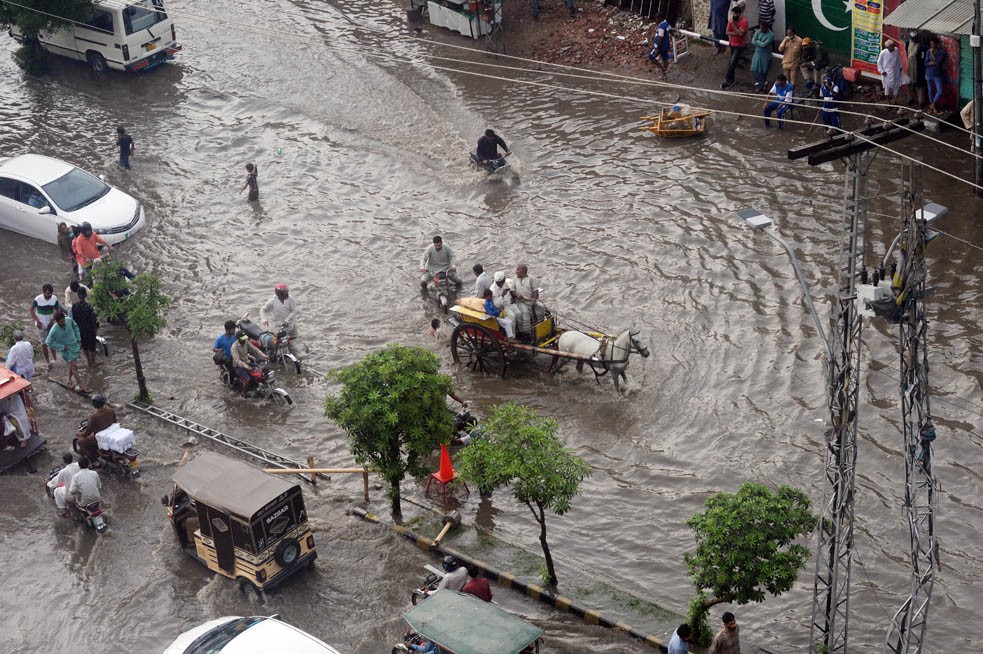
How does the city plan to cope with the stagnant water situation that accompanies Monsoon every year?

For Muhammad Usman, wading through knee-deep rainwater around Lakshami Chowk is nothing new. He is used to tackling this situation every year from his childhood days. He does not believe that things will change in his lifetime.
A resident of Gowalmandi, Usman is a manual labourer. He leaves for work early in the morning and comes back home late at night. During the Monsoon season, however, it gets difficult for him to set foot out of the house.
There are 26 documented points in the provincial capital historically known for the accumulation of rainwater, Lakshmi Chowk being one of those. Others are Bhati Gate, Sheranwala Gate, Eik-Moria Pul, GPO, Nabha Road, Firdous Market, Do-Moria Pul, Kashmir Road, Cooper Road, Lytton Road, Chowk Nakhuda, Lawrence Road, Usman Block in New Garden Town, Link Road (Model Town), Sultan Ahmed Road in Ichhra, B-Block Tajpura, General Hospital/Qainchi Stop, Tikka Chowk Johar Town, Empress Road / Haji Camp, Qurtaba Chowk, Shah Jamal, City railway station, Baghechi Seithan on GT Road, Multan Road near LESCO Grid and the Karim Block Market.
Monsoons descend on the province somewhere around the beginning of July and continue till the end of September. According to the latest five-year data regarding rainfall, Lahore received the most rain on July 3, 2018, at 288 mm. Earlier, the city recorded 177 mm of rain on September 4, 2014, 96.6 mm on September 2, 2016, 77 mm on June 28, 2017, and 67 mm of rainfall on July 7, 2015.
Environmentalists say that the mushroom growth of private housing societies, unplanned urbanisation and commercialisation followed by a general lack of civic facilities has made the provincial metropolis prone to uncontrollable situations during natural calamities, especially rain. According to them, the impact of climate change is now more apparent than ever. The provincial capital is witnessing short-duration intense rainfall resulting in urban flooding.
According to city planners, urban flooding is caused by the accumulation of water in areas where drainage systems are underdeveloped and there is a lack of storm sewers. They say that since the natural flow of rainwater in Lahore has always been from south to north-west - where the River Ravi flows - the central parts of the city often face urban flooding.
Water and Sanitation Agency (WASA) is responsible for developing systems for drainage of rainwater in the city. The total coverage area of WASA is 350 sq km, with a sewer length of 5,187 km. WASA has 13 major disposal stations. 113 lift stations have also been established in the city to manage the 55.70 km primary drains, which dispose of their water in River Ravi, the only disposal site for water in the city.
It is pertinent to mention here that all rainwater drains, which were constructed by Lahore Development Authority (LDA) in the recently developed residential societies have more or less turned into sewerage drains. This shows a lack of planning. New sewerage drains have not been planned in years and the capacity of the existing drainage system has not been increased.
After calculating future needs, WASA has envisaged a plan to lay down several tunnels, e.g. from Haji Camp till Gulshan-e-Ravi, Gulshan-e-Ravi to Larax Colony and Gulberg to Gulshan-e-Ravi. The first of these projects will cost approximately Rs13 billion and will be completed using micro-tunnel boring technology.
The new line will replace many of the pre-partition sewerage lines, says WASA Managing Director Syed Zahid Aziz. He says that laying of this trunk sewerage line will not cause any inconvenience for the general public as there will be targeted excavations and no trench digging.
Laying down a sewerage system in Lahore has always been considered a big problem because of the tremendous digging involved. But with the introduction of micro-tunnelling technology, this problem will be overcome.
Aziz further says that the agency is the first to use the micro-tunnelling digging technique in Pakistan, which is now being used worldwide for water supply and drainage by sanitation sectors. He says that micro-tunnel boring machines are similar to tunnel boring machines (TBM) but on a relatively smaller scale.
The biggest advantage of these machines is that no shifting of gas, water supply, electricity and phone lines will be required as a result. As most of the waterlines, internet cables, telephone lines etc. are laid two to three meters deep in the ground whereas the new sewer line will be laid down about 28 to 30 feet deep.
One side of the new line will cover most of the central Lahore, including Garhi Shahu, Shimla Hill, Egerton Road, Lakshami Chowk, Nabha Road, Jain Mandir, Chauburji, Samanabad and Gulshan-e-Ravi. The other side of the drain will cover Shadman, Gulberg, Samanabad, Bagh Gul Begum - and Mozang and etc. According to Aziz, the government has already approved this project and it is in the final stages of being formally launched.
Meanwhile, emergency camps have been established in the city and machinery placed on critical points. A speedy mobile squad has been established for troubleshooting of dewatering sets. Cleaning of roadside drains has been completed.
Once the new sewer/drainage plan is successfully executed, Muhammad Usman, along with the other residents of areas surrounding Lakshami Chowk, may witness drier roads during the Monsoon season. "Maybe next year I will be able to cross the roads riding my bicycle, without getting my clothes wet. That’ll be something," he concludes.